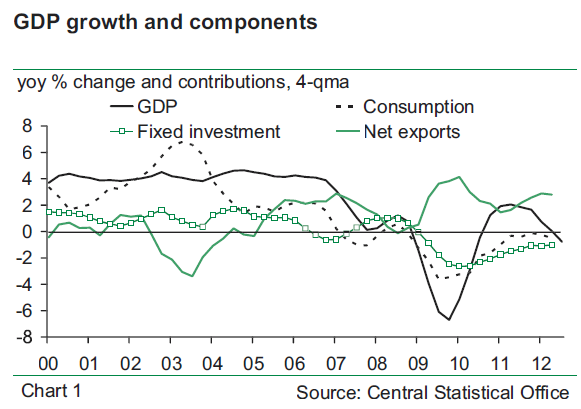When the global financial and economic crisis struck in fall 2008, Hungary appeared to be particularly vulnerable, burdened by high levels of external and public debt resulting from years of overheating. These macroeconomic imbalances were a cause for concern, so much so that international lenders had to intervene. The fact that the IMF was called upon to rescue a Member State of the European Union constituted a rare event.
In the case of Hungary, the processes of macroeconomic adjustment needed in order to reach a sustainable exit from the crisis have been complicated by the rise to power of the Fidesz party in the spring of 2010. By implementing unorthodox policies, which affect foreign investors and the banking sector, the government aims to consolidate the fiscal situation while preserving households’ standard of living. This is not a risk-free strategy; it even burdens medium-term growth prospects so much that it appears to be counterproductive.
Lacklustre growth
Difficult exit from crisis
Hungary entered a weaker pattern of GDP growth in 2007 in the wake of fiscal tightening. As the vulnerabilities of the country were exacerbated by the global crisis, it experienced a severe recession in 2009 (-6.8%), and went through a lacklustre recovery in 2010 and 2011 with GDP expanding by 1.3% and 1.7% respectively. During this short-lived recovery, the main engine of the economy was the export sector, while domestic demand kept decreasing.
Hungary is one of the most open countries in Central Europe in terms of international trade. The openness ratio came in at 189% in 2011, very similar to Slovakia’s and significantly above those of the Czech Republic (155%) and Poland (93%).

Exports were affected by the contraction of the global demand in 2009 but then recovered steadily. They represented 98% of GDP in 2011. More than half of them are directed to the euro area, with Germany being by far the most important destination (25% of the total). The automotive sector accounts for about 20% of exports, but Hungary also is increasingly attractive to Western European firms for administrative and logistic services.
By Alexandre VINCENT
To Read the Entire Report Please Click on the pdf File Below.
- English (UK)
- English (India)
- English (Canada)
- English (Australia)
- English (South Africa)
- English (Philippines)
- English (Nigeria)
- Deutsch
- Español (España)
- Español (México)
- Français
- Italiano
- Nederlands
- Português (Portugal)
- Polski
- Português (Brasil)
- Русский
- Türkçe
- العربية
- Ελληνικά
- Svenska
- Suomi
- עברית
- 日本語
- 한국어
- 简体中文
- 繁體中文
- Bahasa Indonesia
- Bahasa Melayu
- ไทย
- Tiếng Việt
- हिंदी
Hungary: Dancing On A Volcano
Published 12/24/2012, 12:51 AM
Updated 03/09/2019, 08:30 AM
Hungary: Dancing On A Volcano
3rd party Ad. Not an offer or recommendation by Investing.com. See disclosure here or
remove ads
.
Latest comments
Install Our App
Risk Disclosure: Trading in financial instruments and/or cryptocurrencies involves high risks including the risk of losing some, or all, of your investment amount, and may not be suitable for all investors. Prices of cryptocurrencies are extremely volatile and may be affected by external factors such as financial, regulatory or political events. Trading on margin increases the financial risks.
Before deciding to trade in financial instrument or cryptocurrencies you should be fully informed of the risks and costs associated with trading the financial markets, carefully consider your investment objectives, level of experience, and risk appetite, and seek professional advice where needed.
Fusion Media would like to remind you that the data contained in this website is not necessarily real-time nor accurate. The data and prices on the website are not necessarily provided by any market or exchange, but may be provided by market makers, and so prices may not be accurate and may differ from the actual price at any given market, meaning prices are indicative and not appropriate for trading purposes. Fusion Media and any provider of the data contained in this website will not accept liability for any loss or damage as a result of your trading, or your reliance on the information contained within this website.
It is prohibited to use, store, reproduce, display, modify, transmit or distribute the data contained in this website without the explicit prior written permission of Fusion Media and/or the data provider. All intellectual property rights are reserved by the providers and/or the exchange providing the data contained in this website.
Fusion Media may be compensated by the advertisers that appear on the website, based on your interaction with the advertisements or advertisers.
Before deciding to trade in financial instrument or cryptocurrencies you should be fully informed of the risks and costs associated with trading the financial markets, carefully consider your investment objectives, level of experience, and risk appetite, and seek professional advice where needed.
Fusion Media would like to remind you that the data contained in this website is not necessarily real-time nor accurate. The data and prices on the website are not necessarily provided by any market or exchange, but may be provided by market makers, and so prices may not be accurate and may differ from the actual price at any given market, meaning prices are indicative and not appropriate for trading purposes. Fusion Media and any provider of the data contained in this website will not accept liability for any loss or damage as a result of your trading, or your reliance on the information contained within this website.
It is prohibited to use, store, reproduce, display, modify, transmit or distribute the data contained in this website without the explicit prior written permission of Fusion Media and/or the data provider. All intellectual property rights are reserved by the providers and/or the exchange providing the data contained in this website.
Fusion Media may be compensated by the advertisers that appear on the website, based on your interaction with the advertisements or advertisers.
© 2007-2024 - Fusion Media Limited. All Rights Reserved.
